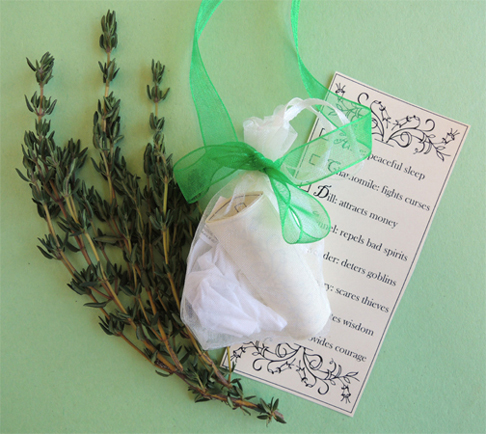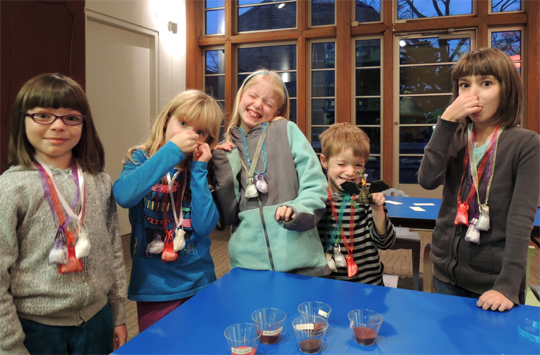 Enter the realm of mystery, magic, spells, sorcery, and…smoked paprika. That’s right. Never underestimate the POWER of roast chicory! First, we made herbal amulets. Then we votes with our noses. The burning question? Which spice smells most like dragon’s blood? There was some serious sniffing going on at To Be Continued, our weekly story time for 6-8 year-olds.
Enter the realm of mystery, magic, spells, sorcery, and…smoked paprika. That’s right. Never underestimate the POWER of roast chicory! First, we made herbal amulets. Then we votes with our noses. The burning question? Which spice smells most like dragon’s blood? There was some serious sniffing going on at To Be Continued, our weekly story time for 6-8 year-olds.
We read Charmed Life by Diana Wynne Jones (Greenwillow Books, 1977). When Cat Chant and his older sister Gwendolen become orphans, Cat is quite happy to settle down quietly in their village. But Gwendolen is set on ruling the world, and writes a mysterious letter to a powerful enchanter named Chrestomanci. To Cat’s surprise (and Gwendolen’s glee), Chrestomanci agrees to adopt the children and raise them in his magnificent castle. However, when Chrestomanci and his constituents fail to fawn over the spoiled Gwendolen, she launches a vengeful campaign to create magical mayhem. Things get even more complicated when Gwendolen departs to a parallel world, dragging her double (a girl named Janet), into Cat’s world. It’s up to Cat and Janet to set right all the problems Gwendolen’s created. But in the process, they uncover Gwendolen’s worst plot yet – one that puts Cat in grave danger.
For the hands-on portion of our program, we made these nifty herbal amulets. You can find instructions for that project here.
 But there was an additional olfactory activity! In Charmed Life (and, in fact, all the books in the Chronicles of Chrestomanci series) dragon’s blood is one of the most powerful and dangerous substances in the known worlds. It’s described as having a powerful, distinct, and horrible odor, even when it’s dried into a powder.
But there was an additional olfactory activity! In Charmed Life (and, in fact, all the books in the Chronicles of Chrestomanci series) dragon’s blood is one of the most powerful and dangerous substances in the known worlds. It’s described as having a powerful, distinct, and horrible odor, even when it’s dried into a powder.
So while purchasing the herbs for the amulets, I also bought several strong smelling, reddish-brown spices (it was an interesting shopping day, let me tell you). In the end, I decided on chipotle, roast chicory, smoked paprika, hot cayenne, and sumac. I put each spice in a plastic glass with a label. During the program, the kids sniffed the glasses and voted on which one they thought smelled like dragon’s blood.
There was quite a lot of yelling, laughing, and carrying-on, but in the end, we had our winner…sumac!
 If you haven’t read Charmed Life, or anyone of the other books in the Chronicles of Chrestomani series, I can’t recommend them enough. I love how Diana Wynne Jones writes her characters and create her magic. I love her sense of humor and her amazing descriptions. The Pinhoe Egg is a book I re-read annually, because it’s like visiting family. Conrad’s Fate comes in a close second. It’s a bit like Downton Abbey…with magic!
If you haven’t read Charmed Life, or anyone of the other books in the Chronicles of Chrestomani series, I can’t recommend them enough. I love how Diana Wynne Jones writes her characters and create her magic. I love her sense of humor and her amazing descriptions. The Pinhoe Egg is a book I re-read annually, because it’s like visiting family. Conrad’s Fate comes in a close second. It’s a bit like Downton Abbey…with magic!
